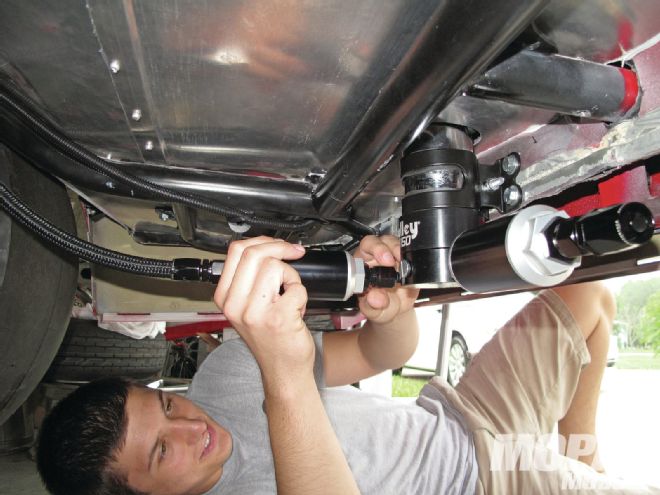
Our latest project is a 2010 Dodge Challenger that we're building into a dedicated drag racing car. Owned by local Mopar guy Fred Menditto, this '10 Dodge will be driven at local and national events by Fred's son Rick when completed. We're sure you remember from previous issues of Mopar Muscle that although this particular Challenger was acquired with less than 20,000 miles, it had also been in a rollover accident resulting in what's called a salvage title, which, in Florida, means it can't be titled for street use.
Being an avid drag racer with two now-grown children who developed great racing skills in the Junior Dragster category, Fred figured this would be a great car to build into a dedicated race car. As a licensed auto dealer, Fred picked this car up at a local auto auction for far less than an un-wrecked Challenger would bring, then sold the remaining good interior parts and accessories to offset much of the cost of the car. After a little frame straightening and bodywork, the car was ready to turn into a race car.
In previous articles, we've shown how we back-halved our Challenger for big tires, four-link suspension, and a fabricated nine-inch rear end housing from Applied Racing Technology. We also showed you the upgrades we made to the front of the car including Eibach lowering springs and Lakewood drag race front shocks. To replace the heavy factory disc brakes, Aerospace Components fabricated a front brake kit for our Challenger and even changed the front bolt pattern to fit our Weld wheels.
We've also been accumulating engine and transmission parts for our car and are nearly ready to assemble and dyno our engine with the help of Indy Cylinder Head, so we figured we'd better address one of our car's more important systems: the fuel. Since this Challenger's rear floors and suspension were gutted in favor of aftermarket parts, using the stock fuel system is out of the question. Also, the late-model Hemi engine we're building will be carbureted with a Holley Ultra HP four-barrel, not fuel injected like the factory engine, so the factory high-pressure fuel system just isn't compatible.
For this application, we chose to build a typical race car fuel system with parts from Holley and Summit Racing Equipment. Starting from the rear, we used one of Summit Racing's five-gallon, foam-filled fuel cells, which is legal for drag racing under all sanctioning bodies. This fuel cell is equipped with dual rear sump outlets, though we will only use one of them for this application. The additional sump is good to have, though, in case we decide to run tandem fuel systems for a more powerful engine or nitrous oxide.
We chose Holley's 150 HP "black" fuel pump for this application, as it can support engines with up to 750 horsepower. The pump gas late-model Hemi we're building won't exceed this power level, so the Holley pump is a great, economical choice for this Challenger. The HP pump has a free-flow (needle valves open) capacity of 140 gallons per hour (gph), and will flow 120 gph with the regulator set at 9 psi. This pump does require a regulator, and we chose Holley's four-port billet-aluminum unit. We'll only use two of the ports for now, but if we upgrade to multiple carbs in the future, this regulator will make it easy.
To ensure our Ultra HP carb gets plenty of clean fuel, we chose a pair of Holley's billet fuel filters. Before the pump, we installed a 10 micron filter to pre-filter any large particles from the fuel. Ahead of the pump, we installed a 100 micron filter to ensure no debris makes its way to the carburetor bowls which can cause problems such as clogged jets or stuck needle and seat valves. Black nylon braided fuel line from Summit Racing Equipment was used to plumb the fuel system from the fuel cell all the way to the carb that will be installed on the late-model Hemi.
We'll actually be talking more about the Holley Ultra HP carburetors in a later issue, as we'll test both an 850-cfm and 950-cfm unit when we have the engine on the dyno. The Ultra HP is Holley's latest offering, and the body of the carb is constructed from lightweight aluminum, making this carb over four pounds lighter than the original HP carburetor. The bowls are also 20 percent bigger and baffled, and this carb is fully tunable, making this a great choice for racing applications. We selected our carbs in Holley's "hard core gray" color, and we'll let you know which one makes the most power on our Hemi in a future issue.
As we get our '10 Challenger project car closer to being finished, we're looking forward to getting the car to the dragstrip. Without knowing exactly what the car will weigh or how much horsepower and torque the engine will have, it's hard to predict how our Challenger will run. Since bracket racing is more about consistency than speed, we're hoping to provide driver Rick Menditto with a car capable of going rounds as well as going fast. The rest will be up to his driving skills!
Price Tag
Holley "Black" Race Fuel Pump$164.95 Holley Fuel Filters$63.44 each Holley Fuel Pressure Regulator$183.95 Holley Ultra HP 850-cfm carb$757.95 Holley Ultra HP 950-cfm carb$797.95 Summit Racing Equipment 5-Gallon Fuel Cell$94.95 Fuel Line and Fittings$150.00